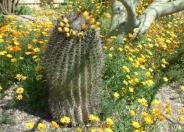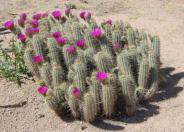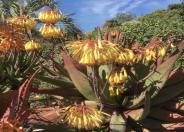
Common name:Balloon Cactus
Botanical name:Parodia magnifica
Parodia magnifica, still known in cultivation with its old name Eriocactus magnificus, is a bluish-green geometric globular cactus with wool that grows in clusters and produce absolutely brilliant yellow flowers. These cacti develop a slight depression on the crown, which may become distorted with age. Parodia magnifica glistens under a haze of pale yellow spines. Cristate (wavy edged) forms are avalible but these are usually grafted plants.

Common name:Compass Barrel Cactus
Botanical name:Ferocactus cylindraceus
Globe-shaped cactus grows slowly to 2' x 1-1/2'. Stem is medium green and spines are red/yellow. Flowers are yellow to orange and appear late spring to early summer. Good for naturalistic landscapes. Accepts reflected sun. Native to Sonoran and Mojave deserts.

Common name:Strawberry Hedgehog
Botanical name:Echinocereus engelmannii
Clumping cactus grows slowly to 1' x 2'. Stems are medium green with brown spines. Flowers appear in spring, they are magenta and very showy. Vibrant spring color. Good for small spaces. Accepts full sun. Native to the Sonoran and Mojave Deserts.

Common name:Cooper's Aloe
Botanical name:Aloe capitata var. quartziticola
The island nation Madagascar, which lies to the east of southern Africa in the Indian Ocean, has many wonderful species of Aloe. One of these is Aloe capitata var. quartziticola, native to the southern part of the island’s central highlands. This single-headed plant has stemless rosettes to 2 feet across. The fleshy tapered leaves are a milky blue-gray color under less sunny conditions, becoming purple-tinged with stronger sun. The margins are edged with small triangular dark red teeth. The branched flower stalk of Aloe capitata var. quartziticola emerges in the latter half of winter (typically in February at the Ruth Bancroft Garden), rising to a height of 3 feet or more. Each branch is topped with a rounded head of flowers, tubular at the bud stage and widening at the mouth when they open to become narrowly bell-shaped. The buds are a vivid glossy orange, while the open flowers are yellow. Unlike most other species of Aloe, this one’s flowers do not necessarily open in sequence from bottom to top, often starting somewhere in between. The long pedicels (the stalks of the individual flowers) are reddish. It tolerates full sun to part sun to shade but does best with well draining soil. Established plants need only occasional water.
Designer: Ruth Bancroft Garden
Photographer: Vicki Anderson
Incorporate compost 6" into your soil to retain water, reduce compaction, feed earthworms, and provide valuable nutrients to your plants.
Drip and other smart irrigation delivers water directly to roots, allowing no excess water for weeds.